News

Thu, 06/23/2016 | UW Today
How well do facial recognition algorithms cope with a million strangers?A team of UW researchers, led by CSE assistant professor Ira Kemelmacher-Shlizerman, is investigating how facial recognition algorithms scale in the MegaFace Challenge. All the algorithms tested experienced a drop in accuracy when given a set million images. This set is much larger than the set of 10,000 images that some algorithms have previously performed with near perfect accuracy against.

Tue, 06/21/2016 | UW Today
UW-led team awarded $1M bioelectronics innovation prize
A team of researchers from the Center for Sensorimotor Neural Engineering, led by EE adjunct associate professor Chet Moritz, has been awarded $1 million as one of three finalists in the GlaxoSmithKline Bioelectronics Innovation Challenge. The team is developing an implantable device that could help restore bladder function for people with spinal cord injuries. The device uses a wireless power transmitter developed by UW associate professor of EE and CSE, Joshua Smith.
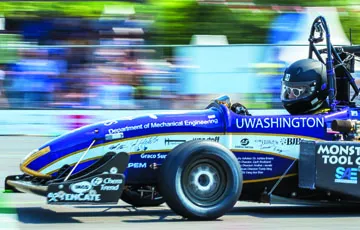
Sun, 06/19/2016 | College of Engineering
UW team places second at Formula SAE Lincoln competitionThe UW Formula Motorsports team placed second overall at the Formula SAE competition in Lincoln. A mere 0.5 point difference, out of a 1,000 point total, separated UW's score from the first place team.

Tue, 06/14/2016 | College of Engineering
The College of Engineering and Burke Museum partner on a 3-D scan-and-print project of mammoth proportionsThe Burke Museum plans to display a giant Columbian Mammoth in its new building, set to open in 2019; however, only 20% of the mammoth’s bones survive. So museum staff have partnered with College of Engineering students and instructors who are taking advantage of 3-D printing technology to reproduce the rest of the mammoth.
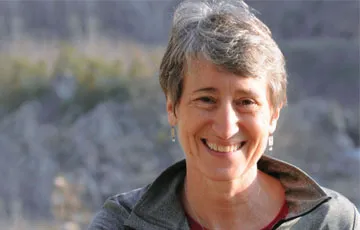
Mon, 06/06/2016 | College of Engineering
Alumna Sally Jewell selected as 2016 UW commencement speaker and ASLD award recipientSally Jewell, U.S. Secretary of the Interior and mechanical engineering alumna, will be the featured speaker at the UW’s Commencement exercises on Saturday, June 11. Jewell was also acknowledged by the UW with the Alumna Summa Laude Dignata award, which is the highest award the UW and the UW Alumni Association can bestow upon a graduate.

Tue, 05/31/2016 | UW Chemical Engineering
Gov. Inslee appoints ChemE UG Austin Wright-Pettibone as student regentGov. Jay Inslee named Austin Wright-Pettibone, a Chemical Engineering undergraduate, as the next student member of the University of Washington Board of Regents for the 2016-17 school year. Wright-Pettibone becomes the first undergraduate since 2008 to be selected as the UW's student regent.
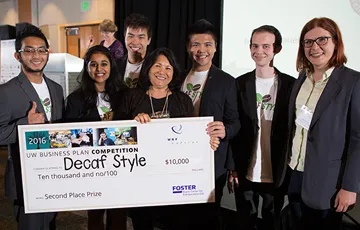
Tue, 05/31/2016 | Foster School of Business
Big Wins for ChemE at UW Business Plan CompetitionAll three Chemical Engineering Entrepreneurial Design teams took home prizes at the UW Business Plan Competition. The team concepts included Decaf Style, a way to instantly decaffeinate beverages; Iconic Windows, a battery membrane that reduces energy costs; and Coulomb Sea, a smart electronic charger.
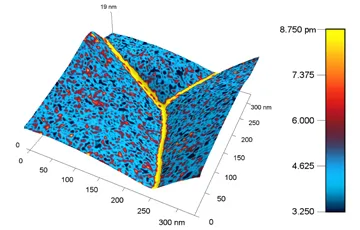
Tue, 05/31/2016 | UW Today
Tiny probe could produce big improvements in batteries and fuel cellsME professor Jiangyu Li and colleagues have developed a tiny probe capable of reading variations in the nanoscale particles that power batteries and fuel cells. The rate at which these particles react determines how fast batteries charge and how much power they can provide. This new probe could improve understanding of electrochemical systems, thus enabling the development of higher performance batteries and fuel cells.
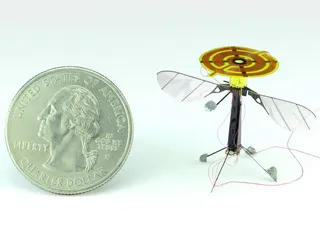
Thu, 05/19/2016 | UW Today
Using static electricity, insect-sized flying robots can land and stick to surfacesA team of roboticists including ME assistant professor Sawyer Fuller have developed a flying, insect sized robot, nicknamed the RoboBee, which can perch on surfaces like wood or leaves using static electricity. The amount of energy required to perch is 1000 times less than that required to hover, so this breakthrough could dramatically extend the fight time of these tiny drones.

Tue, 05/17/2016 | UW Today
UW team first to measure microscale granular crystal dynamics
ME assistant professor Nicholas Boechler and UW engineers have, for the first time, analyzed interactions between microscale granular crystals. Granular materials resonate into complex patterns when forces are applied to them. Microscale granular crystals have significantly different reactions to forces than better-understood macroscale particles. Understanding how microscale granular crystals self-assemble in response to forces could enable faster and less expensive ways to manufacture microstructed materials like spacecraft shielding.
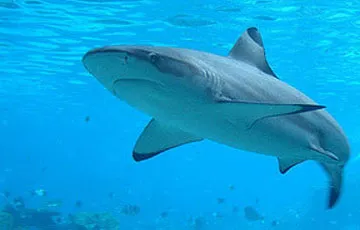
Fri, 05/13/2016 | UW Today
Proton-conducting material found in jelly that fills organs of sharks, skates and raysSharks, skates, and rays use networks of electrosensory organs to detect the weak electrical fields produced by prey and other animals. MSE affiliate associate professor Marco Rolandi and collaborating researchers determined that a proton-conducting material found in the jelly of these organs may explain how electrical signals are transmitted from surface pores to electrosensory cells.
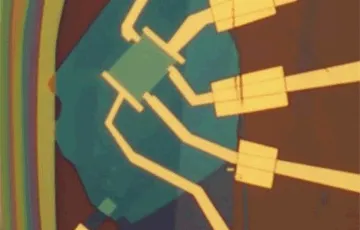
Fri, 05/13/2016 | UW Today
UW researchers unleash graphene ‘tiger’ for more efficient optoelectronicsMSE associate professor Xiaodong Xu and colleagues have developed a promising approach to increasing optoelectronic efficiency. The key to making efficient light-captured energetics possible is to coax one photon into stimulating multiple electrons. Xu directed photons towards a "superlattice" of graphene sandwiched between two layers of boron-nitride. The superlattice creates regions of huge electron density, where one energized photon can transfer its energy to as many as five electrons. According to collaborator Sanfeng Wu, “Graphene is a tiger with great potential for optoelectronics, but locked in a cage. The singularities in this superlattice are a key to unlocking that cage and releasing graphene’s potential for light harvesting application.”

Wed, 05/11/2016 | UW Today
Paper gets 'smart' with drawn-on, stenciled sensor tagsUW computer engineers collaborated with Disney Research and Carnegie Mellon researchers to give a piece of paper sensing capabilities. The paper can respond to gesture commands and connect to the digital world. The method relies on small radio frequency (RFID) tags that are stuck on, printed or drawn onto the paper to create interactive, lightweight interfaces that can do anything from controlling music using a paper baton, to live polling in a classroom.

Wed, 05/11/2016 | UW Today
UW researchers secure prestigious MURI grants for self-cooling lasers and fluid mechanicsThree Multidisciplinary University Research Initiative grants were awarded to UW engineering research projects by the U.S. Department of Defense. UW Electrical Engineering professor Radha Poovendran leads an effort to develop novel defenses against cyberattacks. Materials Science & Engineering assistant professor Peter Pauzauskie's team has unveiled an approach to cooling liquids using laser light. And Alberto Aliseda, associate professor in Mechanical Engineering, is part of a team addressing problems in controlling fluid sprays.

Mon, 05/09/2016 | UW Today
This five-fingered robot hand learns to get a grip on its own
UW engineers have built a 5-fingered robot hand that learns dexterous manipulation on its own, rather than having its actions programmed. Intricate tasks like rolling, pivoting, bending, and sensing friction are notoriously difficult for robots. Now, engineers in the UW Movement Control Laboratory have built a robot hand that can perform dexterous manipulation and learn from its own experience without needing human direction.

Thu, 05/05/2016 | UW Today
Two-minute warnings make kids’ ‘screen time’ tantrums worseGiving young children a two-minute warning that screen time is about to end makes transitions away from tablets, phones, televisions and other devices more painful. A new study from HCDE's Alexis Hiniker asked families with children aged 1 to 5 to document what circumstances make transitions away from "screen time" smoother or more prone to cause tantrums.

Tue, 05/03/2016 | UW Civil & Environmental Engineering
UW-led team wins $10M EPA grant for air pollution research
CEE professor Julian Marshall will co-lead the Center for Air, Climate and Energy Solutions, a new collaboration between more than 25 U.S. researchers to explore which pollutants are most damaging to people’s health and to detect current levels and sources of pollution. The center will provide guidance to the EPA on how air pollution emissions and concentrations are anticipated to change in the future and will evaluate strategies for reducing air pollution.
The center is funded by a $10 million Air, Climate and Energy (ACE) grant from the U.S. Environmental Protection Agency to help address the nation’s pressing need for better air quality.
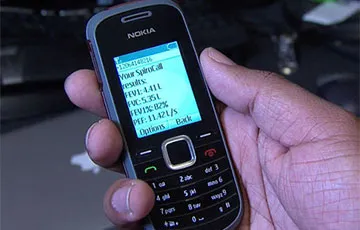
Tue, 05/03/2016 | UW Today
New health sensing tool measures lung function over a phone call, from anywhere in the worldSpiroCall enables patients to measure lung function over a phone call from all types of phones, not just smartphones. "We wanted to be able to measure lung function on any type of phone you might encounter around the world — smartphones, dumb phones, landlines, pay phones," said Shwetak Patel, Washington Research Foundation Endowed Professor of Computer Science & Engineering and Electrical Engineering at the UW. "With SpiroCall, you can call a 1-800 number, blow into the phone and use the telephone network to test your lung function."
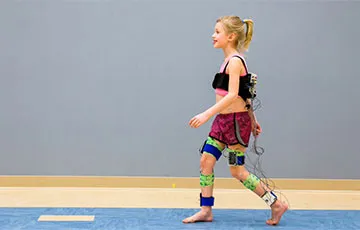
Wed, 04/27/2016 | UW Today
‘Walk-DMC’ aims to improve surgery outcomes for children with cerebral palsyChildren with cerebral palsy may undergo invasive surgeries — lengthening tendons, rotating bones, transferring muscles to new locations — in hopes of improving their ability to walk or move. But not all children see improvement after those operations. Kat Steele, an assistant professor in Mechanical Engineering, has collaborated to develop a new quantitative assessment of motor control in children with cerebral palsy called Walk-DMC, which could help predict which patients are — or are not — likely to benefit from such aggressive treatment.

Mon, 04/18/2016 | UW Today
Board of Regents approves first University of Washington master’s program through Global Innovation Exchange
The new MSTI degree is the first U.S.-based program offered through the Global Innovation Exchange (GIX). Students will work on real-world challenges with faculty experts and industry professionals in a project-based, globally-focused learning environment.
GIX is a partnership between the UW — three engineering programs and the business, information and law schools — and Tsinghua University in China, with foundational support from Microsoft.
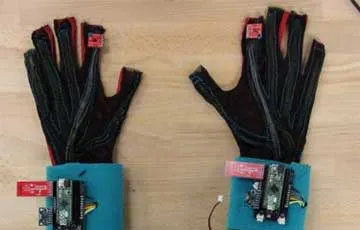
Fri, 04/15/2016 | UW Today
UW undergraduate team wins $10,000 Lemelson-MIT Student Prize for gloves that translate sign languageThe "SignAloud" gloves developed by UW sophomores Thomas Pryor (A&A) and Navid Azodi (Bus. Admin.) translate American Sign Language into speech and text. "Many of the sign language translation devices already out there are not practical for everyday use. Some use video input, while others have sensors that cover the user’s entire arm or body, says Pryor, an undergraduate researcher in the Composite Structures Laboratory and software lead for the Husky Robotics Team." Their invention won them a $10,000 Lemelson-MIT Student Prize, a nationwide search for the most inventive undergraduate and graduate students.
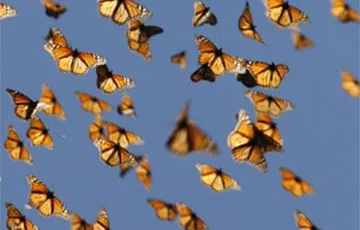
Thu, 04/14/2016 | UW Today
Scientists crack secrets of the monarch butterfly’s internal compassThe secrets of the internal, genetically encoded compass that the monarchs use to determine the direction they should fly each fall have been revealed by a research team that includes assistant professor Eli Shlizerman (EE, Math). "Their compass integrates two pieces of information — the time of day and the sun's position on the horizon — to find the southerly direction," said Shlizerman, who partnered with colleagues at the University of Michigan and the University of Massachusetts to model how the monarch’s compass is organized within its brain.
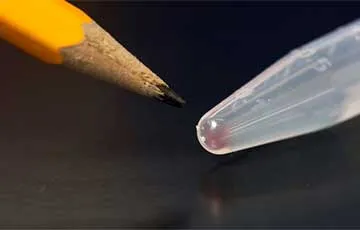
Thu, 04/14/2016 | UW Today
UW team stores digital images in DNA — and retrieves them perfectlyA team of UW engineering and Microsoft researchers has detailed one of the first complete systems to encode, store — and retrieve — digital data using DNA molecules, which can store information millions of times more compactly than current archival technologies. Authors of the paper are UW doctoral students James Bornholt (CSE) and Randolph Lopez (BioE ), UW associate professors Luis Ceze (CSE) and Georg Seelig (EE, CSE), and Microsoft researchers and UW CSE affiliate faculty Doug Carmean and Karin Strauss.

Fri, 04/08/2016 | UW Today
UW-led research team wins $7.5M MURI grant to defend against advanced cyberattacks
A research team led by Radha Poovendran has won a $7.5 million grant from the U.S. Department of Defense to better model and mount defenses against stealthy, continuous computer hacking attacks known as "advanced persistent threats."
"... these threats exploit vulnerabilities and persist over a very long time and they're very difficult to detect," said Poovendran, chair of UW Electrical Engineering and director of the Network Security Lab, which he founded in 2001. "Right now, there is no good understanding of the interactions in these complex cyberattacks or how to mitigate them."
The MURI team also includes UW co-investigator and electrical engineering associate professor Maryam Fazel.

Wed, 04/06/2016 | UW Today
Rajesh Rao wins 2016 Guggenheim Fellowship
Rajesh Rao is among 3 UW professors and 178 U.S. and Canadian scholars, artists, and scientists recognized this year by the Guggenheim Foundation.
Rao is the director of the Center for Sensorimotor Neural Engineering, a professor of computer science & engineering, and an adjunct professor in the electrical engineering and bioengineering departments. His research spans the areas of computational neuroscience, artificial intelligence, and brain-computer interfacing. With his collaborators, he has proposed theories of how the brain might work based on computational ideas such as predictive coding, Bayesian modeling and reinforcement learning. He has proposed new methods for robotic learning based on how children learn by watching and imitating others. Rao's group was the first to demonstrate direct brain control of a humanoid robot in 2006 and direct brain-to-brain communication between humans in 2013.
Read more: Guggenheim Fellowship » | UW CSE announcement